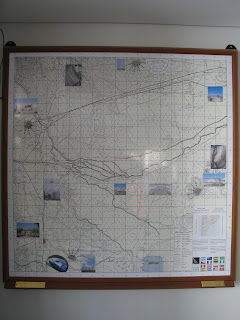
Inside the tank is a liner, larger than this model.

You can see the three white circles on the top of the liner. The dome on top is an actual dome that goes in each of those three white circles. The dome protects the photomultiplier tube (PMT) pictured below. PMTs detect flashes of light and each tank has three of them.

This is a map of the array. Each dot, I know they are hard to see in this photo, represents a tank. They light up red when they detect something. Basically cosmic rays hit something high in the atmosphere which sends a cascade of particles down towards earth. The cascade is sort of shaped like a cone. Some of those particles from the cascade then interact with the water in the tanks to produce flashes of light which the PMTs pickup. Based on which tanks see flashes when, the physicists are able to figure out the path of the cosmic ray, which over time would allow them to see if a cosmic rays tend to originate in select places in the universe. At least that's how I understand it.

This is section of a mirror from another detector. There is a model of a building on the left. The building houses five of these mirrors. This section contains 9 individual mirrors, while the actual telescope has 24. These mirrors are used to detect flashes of light in the night sky from cosmic ray interactions.

Here are some of the actual PMTs. Each telescope has 440 of them, so you can think of it as being a camera with 440 pixels, the digital camera I used to take this photo has 12.1 million pixels.

This is what one of the telescopes looks like. You can see the PMTs on the right.

Here's a close up shot of the model of one of the buildings. Again there are four of these buildings included in the array, and I've gone to two of them Los Leones and Coihueco.

One of the complications in using the air in the atmosphere as the detector medium is dust and air density affect how intense the flash of light is. In order to determine if the flash is dim because it was far away or if aerosols were blocking some of the light, they use lasers to take measurements of the atmosphere to calibrate their data. This photo shows what the laser looks like, but again they only open the top during calm weather at night.

No comments:
Post a Comment